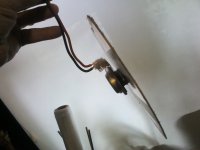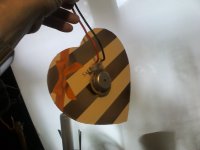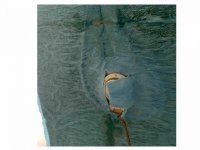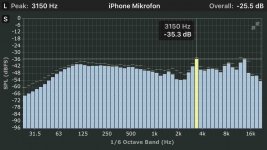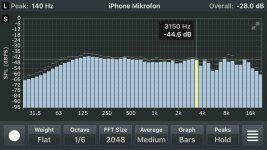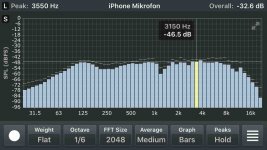this was recorded from youtube using 2mm card dml panels ,it is cyndee peters ,from a test disc quad opus 3,house of the rising sun,so it is easy to compare, as before i would recommend using headphones for listening as this gives a better impression of being there.
for a laugh i will post some pics.
hope you enjoy.
steve
for a laugh i will post some pics.
hope you enjoy.
steve
Attachments
Here's the pics ,try not to laugh,I use what I can get hold of, simplicity is my motto,this is as basic as you can get,2mm card with an exciter stuck on with double sided tape.
This is so easy to improve on,in so many ways, gluing the exciter on,so that the panel doesn't fall off after a week or so(only the left one for some reason) would be a start!
Obviously I have a digital xo so this helps immensely,the panels were run down to 127hz and the bass units were rolled off at 400hz,both 48db slopes,this helps drive the room better,and combat room suck outs in the 100to 300 or so HZ ,which is always a problem!
Steve
This is so easy to improve on,in so many ways, gluing the exciter on,so that the panel doesn't fall off after a week or so(only the left one for some reason) would be a start!
Obviously I have a digital xo so this helps immensely,the panels were run down to 127hz and the bass units were rolled off at 400hz,both 48db slopes,this helps drive the room better,and combat room suck outs in the 100to 300 or so HZ ,which is always a problem!
Steve
Attachments
Xrk.
I didn't have a clue what you mean,but I was just sitting here listening to some music ,when the penny dropped.
I'm a bit slow ,but I got there eventually.
I know what you are thinking, what a romantic guy, buying that for his wife(I think my wife would pass out with shock if i did ).
She was lucky I waited until she finished with the box!
I like the sound of these panels(not the shape)and will probably make something similar but with a more extended and smoother response.
The idea is to have a large-ish pànel plus a small panel to switch between,or run together, depending how I feel.
The idea was to make a small panel as a tweeter ,but I don't know any tweeters that go down to a few hundred HZ.
One thing I have noticed is that very small panels can be put closer to the wall , without causing the same sort of problems as a large panel.
Steve
I didn't have a clue what you mean,but I was just sitting here listening to some music ,when the penny dropped.
I'm a bit slow ,but I got there eventually.
I know what you are thinking, what a romantic guy, buying that for his wife(I think my wife would pass out with shock if i did ).
She was lucky I waited until she finished with the box!
I like the sound of these panels(not the shape)and will probably make something similar but with a more extended and smoother response.
The idea is to have a large-ish pànel plus a small panel to switch between,or run together, depending how I feel.
The idea was to make a small panel as a tweeter ,but I don't know any tweeters that go down to a few hundred HZ.
One thing I have noticed is that very small panels can be put closer to the wall , without causing the same sort of problems as a large panel.
Steve
You may actually have sonic benefits to a heart shaped panel since it doesn’t support rectangular standing wave modes. It will have less peaks of resonance or wider ones rather than sharp ones. Another shape to consider is the Fibonacci spiral (nautilus shell spiral). Another one is a pentagon. For open baffle speakers, these organic shapes tend to sound better than a rectangle. A circle is one of the worst shapes. Perfect reflection symmetry is bad. A 5 petal flower is actually very good also. Trapezoid is better than a rectangle.
@ANIE
Hi Allan,
That exciter should work out nicely. You will need a sub and XO to get the best performance. Good luck with your build!
Hi Allan,
That exciter should work out nicely. You will need a sub and XO to get the best performance. Good luck with your build!
Ark.
I have actually got two smaller sizes of 2 to 3 mm ply in the heart shape from the art and craft store for that exact reason.
The idea was to glue one of these to the front of the canvas picture frames also from the art and craft store,for a full range panel (getting a bit arty now),I haven't got around to that yet,too many projects on the go at the same time.
Not sure that the shape would have much effect when glued on to the picture frame?
Although this would not take much time to get up and running,I would have to listen to the naked panel first.
Most of the time is taken up by listening to the panels and adjusting them for better sound ,if I feel they are worth it.
Steve
I have actually got two smaller sizes of 2 to 3 mm ply in the heart shape from the art and craft store for that exact reason.
The idea was to glue one of these to the front of the canvas picture frames also from the art and craft store,for a full range panel (getting a bit arty now),I haven't got around to that yet,too many projects on the go at the same time.
Not sure that the shape would have much effect when glued on to the picture frame?
Although this would not take much time to get up and running,I would have to listen to the naked panel first.
Most of the time is taken up by listening to the panels and adjusting them for better sound ,if I feel they are worth it.
Steve
honeycomb card-/paperboard
the honeycomb board has got now on one side 2 additional layers using rice glue and soft table napkins (in total 3 layers, first layer made with paper/printer paper). With the use of rice glue the card-/paperboard get soaked and some altering of the material happens. Within these process steps I've tried to flatten the board with ironing. At the end I did a finish (2x) with very thin rice glue and a spray bottle. The result is quiet good. Tonal balance is good, details are crispy and clear, most of the acoustic instruments have its characteristic and electronic instruments are good too. Voices (male and female) are fine. The only issue for me are the transients of the acoustic guitar. There are some little distortions when a picked string is quieting. I think this is caused by lost joints of the honeycomb structure at the layer.
As a conclusion, I would recommend the use of rice glue on honeycomb card-/paperboard, where one layer has been taken off. The usage with rice glue does impact the soaking and altering of the material. This is the main issue and challenge. For a next experiment with honeycomb card-/paperboard I will first impregnate the material on the surface only with 3 or more thin layers of rice glue using the spray bottle.
The first picture shows the layer side with attached exciter. The second is the pink noise frequency range at the open honeycomb side, the third is the frequency range at the layer side and the forth shows for comparison the frequency range of the 6/9' Goodmans speaker of my stereo set in the living room.
the measurement on the panel are made very close (2') starting at the exciter, going to the edges and crossing the panel; the measurement on the oval speaker is made at 10' approx. The filled bar graphs show the measuring point at the exciter, the small lines are the peak level indicators while crossing/moving the microphone
Hi XRK
Did you made any tests and work with your boards?
this week I've worked on a kind of honeycomb board like yours. It is not that stiff as my other cardboard honeycomb boards. One difference is the type of layer. It is made of Craft/Kraft paper. The cardboard honeycomb with screw mounted exciter sounds in mids and highs very detailed and super clear, it remembers me of the old Quad ESL, but lacking the body. The paper honeycomb lacked in details but tonally is much better balanced for me. So I decided to work on the softer sounding board.
After trying to make them stiffer with a kind of 'papier mache' (modified rice glue), I decided later to take away the layers and made one side with paper and rice glue (mixed with paper and cardboard), because a bigger part of the before soaked layer did not make good contact with the honeycomb structure.
I've now one side open (with the honeycomb structure) and one side with a new layer (picture). The exciter mounted on each side and listening tests of all four sides showed the exciter on the layer side and the ear on the open side as best for me. The sound has some details, voice is again in front as well instruments with percussive sounds. Electronic Organ, acoustic and electric bass has a good body. The efficiency overall is much less than with the cardboard panels but still no problem with an 8 Watts amp.
I think there is a good potential for me to work and improve stiffness on the layer side and partially on the open honeycomb (esthetically a must as you can see;-)
the honeycomb board has got now on one side 2 additional layers using rice glue and soft table napkins (in total 3 layers, first layer made with paper/printer paper). With the use of rice glue the card-/paperboard get soaked and some altering of the material happens. Within these process steps I've tried to flatten the board with ironing. At the end I did a finish (2x) with very thin rice glue and a spray bottle. The result is quiet good. Tonal balance is good, details are crispy and clear, most of the acoustic instruments have its characteristic and electronic instruments are good too. Voices (male and female) are fine. The only issue for me are the transients of the acoustic guitar. There are some little distortions when a picked string is quieting. I think this is caused by lost joints of the honeycomb structure at the layer.
As a conclusion, I would recommend the use of rice glue on honeycomb card-/paperboard, where one layer has been taken off. The usage with rice glue does impact the soaking and altering of the material. This is the main issue and challenge. For a next experiment with honeycomb card-/paperboard I will first impregnate the material on the surface only with 3 or more thin layers of rice glue using the spray bottle.
The first picture shows the layer side with attached exciter. The second is the pink noise frequency range at the open honeycomb side, the third is the frequency range at the layer side and the forth shows for comparison the frequency range of the 6/9' Goodmans speaker of my stereo set in the living room.
the measurement on the panel are made very close (2') starting at the exciter, going to the edges and crossing the panel; the measurement on the oval speaker is made at 10' approx. The filled bar graphs show the measuring point at the exciter, the small lines are the peak level indicators while crossing/moving the microphone
Attachments
Hi Burnt!
What is an XO?
🙂
Allan
Sorry for the abbreviation Allan. XO is indeed a crossover as the guys have told you. So I was recommending that you use a crossover to pass the low frequency range over to a subwoofer, one is perfectly sufficient to start with. You can also use a passive filter, DML’s are just like any other loudspeaker in that regard.
The crossover frequency can be anywhere between 200 to 400 Hz.
The reason I suggest that you use a sub is that although a slim panel will go lower a good sub reaches even deeper and has better power and attack. It also means that as a system you will get higher levels as the exciter excursion at 400 Hz is much smaller than at say 60Hz and so it can take more power without distortion.
I hope that’s clearer and please do ask if you want more detail.
Best
Burnt
Hello, Here is some interesting technology that looks pretty promising xMEMS Announces World's First Monolithic MEMS Speaker Looking at an array of them to make a line source.
Cheers
Steve
Cheers
Steve
Tagis .
I believe these are to fit in ,in ear headphones? They are very ,very small.
Sonitron do larger piezoelectric flat speakers with amplifiers to match,sold though RS in the UK.
I do wonder what they would sound like,I have had my eye on them for a few years now.
Steve
I believe these are to fit in ,in ear headphones? They are very ,very small.
Sonitron do larger piezoelectric flat speakers with amplifiers to match,sold though RS in the UK.
I do wonder what they would sound like,I have had my eye on them for a few years now.
Steve
xMEMS | Products
Close to ear only unfortunately.
But here is an interesting product.
https://product.tdk.com/info/en/catalog/datasheets/piezolisten_commercial_phu_en.pdf
Close to ear only unfortunately.
But here is an interesting product.
https://product.tdk.com/info/en/catalog/datasheets/piezolisten_commercial_phu_en.pdf
But here is an interesting product.
https://product.tdk.com/info/en/catalog/datasheets/piezolisten_commercial_phu_en.pdf
Interesting but it does have a small caveat: "Use the product within six month"
geo
Did anyone try to paint ply panels? I would like to paint mine for cosmetic reasons but am at a point where I really like how they sound and am unsure if painting them will make a significant difference in the spl. Probably the type of paint would matter too. I'm thinking to try a paint that is fairly rigid when dry.
- Home
- Loudspeakers
- Full Range
- A Study of DMLs as a Full Range Speaker
